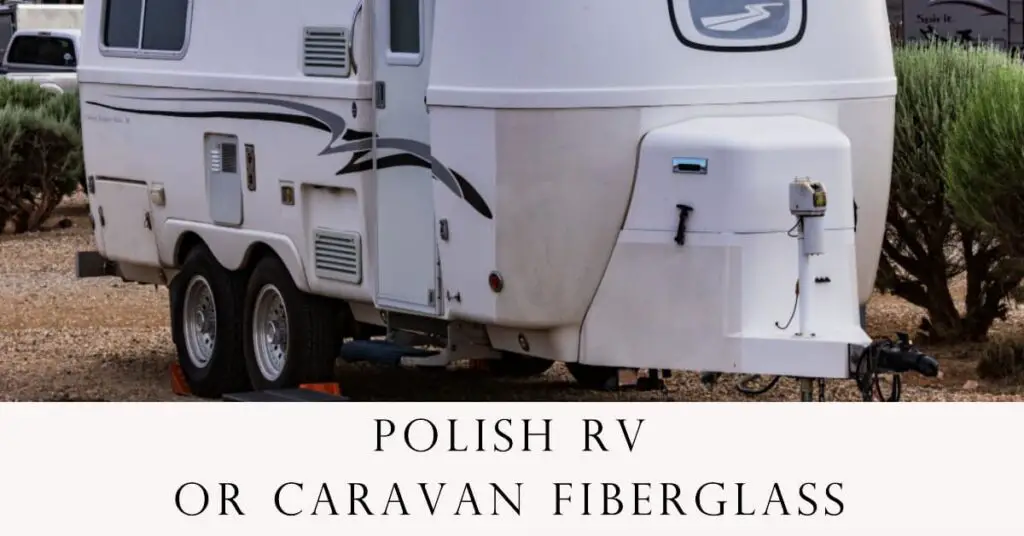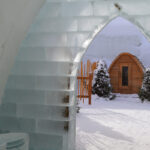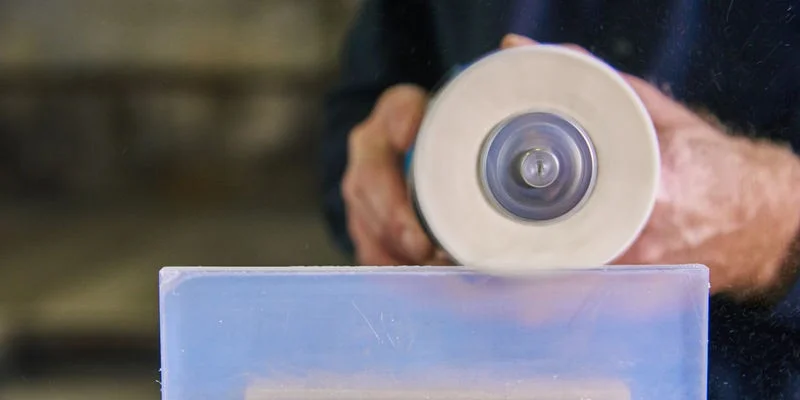RV fiberglass is a durable and versatile material that is used to construct the exterior of many recreational vehicles. However, over time, the fiberglass can become dull, faded, and oxidized due to exposure to the elements. Luckily, there are several ways to restore the shine and make the RV look new again.
Polishing RV fiberglass is a process that involves cleaning, removing oxidation, and applying a protective wax or coating to the surface. The first step is to thoroughly clean the RV using soap, water, and sponges.
It is important not to overlook the roof during this process since it is often exposed to the highest amount of debris and UV damage. Once the RV is clean, it should be rinsed off with a hose and left out to air-dry to prevent streaking.
Then, the oxidation can be removed using a specialized fiberglass cleaner or a combination of baking soda and water. Finally, a protective wax or coating can be applied to the surface to prevent future damage and maintain the shine.

Why Polish RV Fiberglass?
Polishing RV fiberglass is an essential part of RV maintenance that every RV owner should consider. The fiberglass exterior of an RV is exposed to various weather conditions, including rain, snow, and sun. These weather elements can cause the fiberglass to fade, lose its shine, and become dull. Polishing the fiberglass restores the RV’s appearance and protects it from further damage.
Polishing RV fiberglass not only improves the appearance of the RV but also increases its resale value. A well-maintained RV with a shiny exterior is more attractive to potential buyers than a dull, faded one. Polishing the fiberglass can help the RV owner get a higher price when selling the RV.
Polishing RV fiberglass also improves the durability of the RV. The fiberglass exterior of an RV is designed to withstand harsh weather conditions, but it can still wear down over time. Polishing the fiberglass adds a layer of protection that helps prevent further damage from occurring.
In addition to improving the appearance and durability of the RV, polishing the fiberglass also provides protection from harmful UV rays. UV rays can cause the fiberglass to be yellow and fade, but polishing the fiberglass with a UV inhibitor helps prevent this damage.
Overall, polishing RV fiberglass is an essential part of RV maintenance that every RV owner should consider. It improves the appearance, durability, and protection of the RV, and can even increase its resale value.
Preparing Your RV
Before polishing your RV fiberglass, it is essential to prepare the surface properly. This preparation will ensure that the polishing process is successful and that your RV looks new again. Here are some steps to follow:
Clean the RV
The first step is to clean the RV thoroughly. Use soap, water, and sponges to clean the fiberglass exterior. Don’t overlook the roof during this process because it’s often exposed to the highest amount of debris and UV damage.
Use a ladder or a pressure washer to clean hard-to-reach areas. Rinse the RV off with a hose and leave it out to air-dry so there isn’t any streaking.
Remove Dirt and Debris
Before polishing the RV fiberglass, it is essential to remove any dirt and debris from the surface. Use a microfiber towel to wipe down the RV, removing any dirt or debris that may be stuck to the surface. This will ensure that the polishing process is successful and that the surface is smooth.
Avoid Water Spots
Water spots can be an issue when preparing your RV for polishing. To avoid water spots, use a squeegee to remove excess water from the surface. This will ensure that the surface is dry and free of spots, which can affect the final result.
Protect the Surrounding Areas
When preparing your RV for polishing, it is essential to protect the surrounding areas. Cover any areas that you do not want to be polished, such as windows, with masking tape. This will ensure that the surface is polished evenly and that no areas are missed.
By following these steps, you can prepare your RV for polishing and ensure that the final result is a smooth, shiny surface that looks new again.
Tools and Products Needed
To polish RV fiberglass and make it look new again, there are a few tools and products that are essential. These include:
Polish and Wax
To remove oxidation and restore the shine to the fiberglass, a high-quality polish and wax are essential. There are many different products available, but some of the most popular and effective options include:
- Meguiar’s M4965 Marine/RV Fiberglass Restoration System
- 3M Marine Restorer and Wax
- Star Brite Premium Marine Polish with PTEF
- Gel-Gloss RV Wash and Wax
These products are designed specifically for use on fiberglass and will provide long-lasting protection against the elements.
Sponge and Random Orbital Buffer
To apply the polish and wax, a soft sponge is needed. A random orbital buffer can also be used to make the job easier and ensure an even application. Professional detailers often use a buffer to save time and ensure a consistent finish.
Protective Cover
When polishing fiberglass, it’s important to protect the surrounding areas from damage. A protective cover can be used to prevent any accidental scratches or damage to the aluminum siding or other parts of the RV.
Carnauba Wax
Carnauba wax is a popular choice for RV owners who want to protect their fiberglass from the elements. This natural wax provides a long-lasting protective barrier against UV rays, water, and other environmental factors.
Other Products
Other products that may be useful when polishing RV fiberglass include:
- Protect All Fiberglass Oxidation Remover and Color Restorer
- Gel Coat Labs All Marine Surface Cleaner
- Collinite Fiberglass Boat Wax
By using the right tools and products, RV owners can easily restore shine and protect their fiberglass from future damage.
Polishing the Fiberglass Surface
Polishing the fiberglass surface of an RV can restore it to its original shine and luster. This process involves removing oxidation and surface scratches, buffing and polishing the surface, and applying a protective coating.
Removing Oxidation and Surface Scratches
Before polishing, it is important to remove any oxidation and surface scratches from the fiberglass surface. This can be done by using a polishing compound and a buffer. Apply the compound to the surface and work it in with the buffer until the oxidation and scratches are removed.
Buffing and Polishing the Surface
After removing the oxidation and scratches, the fiberglass surface can be buffed and polished to a high shine. This can be done using a marine wax or gel-gloss RV wash and wax. Apply the wax or wash and wax to the surface and work it in with a buffer until the surface is smooth and shiny.
Applying a Protective Coating
To ensure a long-lasting shine and protect the fiberglass surface from future damage, it is important to apply a protective coating. This can be done using a protective finish or marine wax. Apply the protective coating to the surface and work it in with a buffer until it is evenly distributed.
It is important to note that the fiberglass surface should be cleaned and dried thoroughly before polishing. This will ensure that the surface is free of debris and will allow the polishing compound, wax, or protective coating to adhere properly.
In addition to the fiberglass surface, other exterior surfaces of the RV, such as windows, can also be polished using the same process. This can help to improve the overall appearance of the RV and make it look new again.
Overall, polishing RV fiberglass can be a simple and effective way to restore the surface to its original shine and protect it from future damage.
Maintaining the Polished Fiberglass
Once the RV fiberglass has been polished to a shine, it is important to maintain it to keep it looking new. Regular cleaning and waxing can help protect the fiberglass from the elements and UV rays.
There are a variety of cleaning and waxing products available on the market, so it is important to choose the right one for your RV. Some products are specifically designed for fiberglass, while others are more general-purpose. It’s essential to read the label and ensure the product is safe for use on your type of RV.
One popular product for maintaining a polished fiberglass surface is marine polish. This type of polish is designed to protect the fiberglass from saltwater and other harsh marine conditions, making it ideal for RVs that are frequently exposed to the elements.
Another option is to use an RV wash and wax product, which combines cleaning and waxing in one step. These products are convenient and easy to use, but it’s important to choose a high-quality product to ensure the best protection for your RV.
In addition to regular cleaning and waxing, it’s also important to protect the fiberglass from UV rays. Many waxes and polishes contain UV inhibitors to help prevent damage from the sun. It’s also a good idea to park the RV in a shaded area whenever possible to further minimize UV exposure.
Gel-gloss is another popular product for maintaining a polished fiberglass surface. This product is designed to clean, polish, and protect the fiberglass, making it an all-in-one solution for RV maintenance.
Overall, maintaining a polished fiberglass surface requires regular cleaning, waxing, and protection from the elements. By using high-quality products and taking proper care of the RV, owners can keep their fiberglass looking new for years to come.
Tips and Tricks for Polishing RV Fiberglass
Polishing RV fiberglass can be a tedious and time-consuming task, but it is essential to keep the exterior looking new and shiny. Here are some tips and tricks to make the process easier and more effective:
- Clean the surface thoroughly: Before applying any polishes or waxes, it is crucial to clean the surface thoroughly. Use a gentle soap and water solution to remove any dirt, grime, or debris from the surface. Pay special attention to areas that are more prone to sun damage, such as the roof and windows.
- Remove oxidation: If the surface is dull or chalky, it may have oxidation buildup. To remove oxidation, use a gel-coat oxidation remover or a one-step cleaner wax. Apply the product with a microfiber rag and rub in a circular motion until the oxidation is removed.
- Choose the right polish: There are many polishes and waxes available for RV fiberglass, so it’s essential to choose the right one for your needs. Some polishes are designed to remove oxidation, while others are designed to add shine and protect the surface. Choose a polish that suits your needs and follow the manufacturer’s instructions.
- Use elbow grease: Polishing RV fiberglass requires some elbow grease, especially if the surface is heavily oxidized. Use a soft cloth or a power buffer to apply the polish, and rub in a circular motion until the surface is shiny and smooth.
- Apply a protective coating: Once the surface is polished and shiny, it’s essential to apply a protective coating to prevent further damage. Use a high-quality wax or glaze to protect the surface from UV rays and other environmental factors.
- Take care of decals and exterior surfaces: When polishing RV fiberglass, it’s essential to take care of decals and other exterior surfaces. Avoid getting polish or wax on decals, as it can cause them to peel or fade. Use a separate cloth to polish exterior surfaces, such as metal or plastic, to avoid scratching the fiberglass.
- Consider professional help: If the surface is heavily oxidized or yellowed, it may be best to seek professional help. Many companies specialize in RV fiberglass polishing, and they have the tools and experience to get the job done quickly and effectively.
Overall, polishing RV fiberglass requires some time and effort, but it’s worth it to keep the exterior looking new and shiny. With the right tools and techniques, anyone can achieve a professional-looking finish.
Frequently Asked Questions
How can I restore my RV’s fiberglass to its original shine?
To restore your RV’s fiberglass to its original shine, it is recommended to wash the exterior thoroughly with soap, water, and sponges. Don’t forget to clean the roof, which is often exposed to the highest amount of debris and UV damage. After cleaning and rinsing, leave the RV out to air-dry so there isn’t any streaking. Once it’s dry, apply a fiberglass polish or wax to the exterior to restore its shine.
What is the best RV fiberglass polish on the market?
There are many RV fiberglass polishes on the market, and it can be challenging to determine the best one for your needs. Some popular options include Poli Glow, Meguiar’s M5032 Marine/RV One Step Cleaner Wax, and 3M Marine Restorer and Wax. It’s recommended to research and read reviews on different products to determine which one is best for your RV.
How do I remove oxidation from my RV’s fiberglass?
To remove oxidation from your RV’s fiberglass, it’s recommended to use a fiberglass oxidation remover or a rubbing compound. These products can be applied with a microfiber cloth or a buffer. Be sure to follow the instructions on the product carefully and work in small sections at a time. After removing the oxidation, apply a fiberglass polish or wax to protect the surface.
Which RV fiberglass cleaner and polish is the most effective?
The most effective RV fiberglass cleaner and polish depends on your specific needs and preferences. Some products are designed to remove oxidation, while others are formulated to protect the surface from UV damage. It’s recommended to research and read reviews on different products to determine which one is best for your RV.
What is the best way to get a shine back on my motorhome?
The best way to get a shine back on your motorhome is to wash the exterior thoroughly with soap, water, and sponges. After cleaning and rinsing, apply a fiberglass polish or wax to the exterior to restore its shine. Be sure to follow the instructions on the product carefully and work in small sections at a time.
Is there a specific technique for polishing fiberglass on an RV?
There are several techniques for polishing fiberglass on an RV, including hand polishing with a microfiber cloth, using a buffer, or using a polishing wheel. It’s recommended to research and read reviews on different techniques to determine which one is best for your RV. Be sure to follow the instructions on the product carefully and work in small sections at a time.








